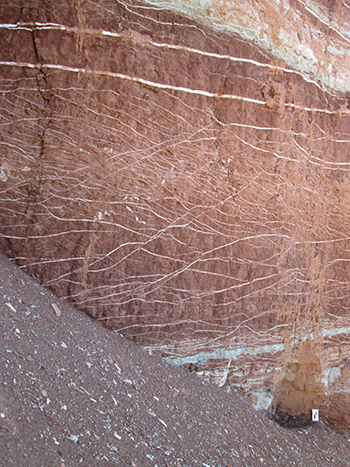Source: Journal of Geophysical Research: Planets
In southern Utah, exposed veins of gypsum run through the Moenkopi Formation, a rock outcrop that formed during the Triassic period. Gypsum, a sulfate mineral that is often found in layered sedimentary deposits, is a more hydrated phase of bassanite, which is found crisscrossing through rock formations on Earth’s galactic neighbor, Mars.
Geoscientists are always on the lookout for analog rock formations between Earth and Mars. Researchers can analyze terrestrial geology and similar Martian formations to make inferences about the geologic processes on Mars without having to employ an overwhelming amount of resources. Young and Chan set out to assess the usefulness of the Moenkopi Formation as an analog for the veins found in the Endeavour and Gale craters on the Red Planet.

Earth’s Moenkopi Formation is made up of mudstone, siltstone, fine sandstone, and gypsum. The researchers performed geometric measurements, image analysis, and geochemical analyses of strontium and sulfur isotopes and created a burial history diagram to look at the changes the Moenkopi Formation has undergone since its genesis.
The team then used data gathered from two rover expeditions to Mars: Opportunity, a Mars Exploration Rover, has made observations in the Endeavour Crater since 2011, and the Mars Science Laboratory Curiosity rover has been sending back data from the Gale Crater since its 2012 landing. The rovers used monochromatic navigation cameras, hazard avoidance cameras, and a suite of spectrometers to make chemical and mineralogy tests of the rock samples.
The authors faced a few challenges in their comparison of the two planets’ rock formations. These included achieving a high-quality resolution image of the Mars veins from the rover expeditions and accounting for the age difference between Martian veins and Moenkopi ones. The Moenkopi Formation is less than 8 million years old, whereas the Martian veins may be 3 billion years old.
Despite these challenges, the analysis revealed many similarities, including the host rock grain size, the texture of the veins, and the vein mineralogy. The Moenkopi and Mars veins are all hydrous calcium sulfate veins and appear to have formed through hydraulic fracturing at low temperatures, which is seen by the fibrous texture and complex geometry all three share. However, the authors were unable to identify the source of the calcium sulfate that turned into veins from the rover data, whereas Moenkopi veins are directly sourced from within the Moenkopi Formation.
Still, the researchers conclude that the Moenkopi veins are useful as terrestrial analogs to Mars veins. For example, someday they could be useful in helping to identify a source of calcium sulfate on the planet to better understand fluid flow in the Martian subsurface. (Journal of Geophysical Research: Planets, https://doi.org/10.1002/2016JE005118, 2017)
—Alexandra Branscombe, Freelance Writer
Citation:
Branscombe, A. (2017), Studying Martian rocks without leaving Planet Earth, Eos, 98, https://doi.org/10.1029/2017EO068315. Published on 01 March 2017.
Text © 2017. The authors. CC BY-NC-ND 3.0
Except where otherwise noted, images are subject to copyright. Any reuse without express permission from the copyright owner is prohibited.

